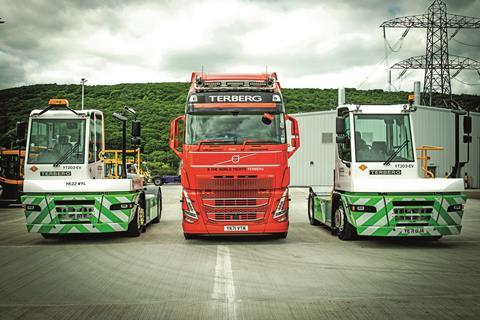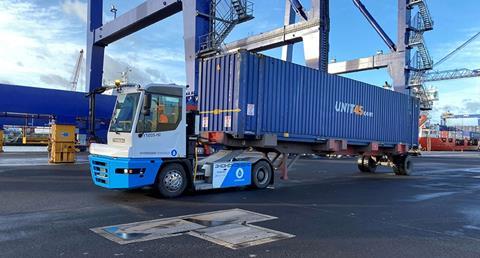Terberg has launched a zero-tailpipe-emission shunter that has a cost parity with diesel. Our colleagues at Commercial Motor have been to take a closer look at it, and explore some of the Dutch manufacturer’s other developments
First launched in 2019, Terberg’s YT203EV is based on the company’s ubiquitous YT193/YT223 yard shunter. Only instead of a Cummins diesel engine and Allison gearbox, it has been fitted with lithium-ion batteries with a capacity of up to 222kWh, which power a ZF CeTrax electric central drivetrain.
Having learned from experience, the vehicle now also features a battery Thermal Management System (TMS), which allows it to be used in ambient temps from -30C to +50C. “The previous version didn’t have it, but it’s vital, even in the UK,” explains Terberg DTS UK MD Alisdair Couper, “and ignoring it would be negligent.”

Seeing as the average power consumption of a YT203EV is just 16kW per hour, even in its most popular 148kWh specification, it has an impressive range of more than nine hours. This said, the Terberg DTS UK sales team are often met with initial resistance from existing customers, who believe an electric shunter could never work in their operations.
“They say they’re in use 24 hours a day, seven days a week, so will never be able to be charged,” explains Couper. “They think they’ll need to swap their batteries in order to keep trucks moving, but that’s simply not true.”
To prove this point, Couper shows potential electric shunter customers the telemetry from their current diesel units. If they don’t have telematics on their tug, Terberg DTS UK installs it, and if it can’t be installed because the vehicle is too old, it loans them one with telemetry.
Couper shows us the data from a typical diesel-powered Terberg shunter, which belongs to a genuine unidentified customer. While it’s accurate that the shunter is indeed working every hour of the day, in this instance it spends 64% of its time idling. According to Couper, this is the norm, with some vehicles idling for up to 80% of the day. With shunters consuming 5 litres of diesel per hour at idle, the amount of money being burned often comes as a massive shock to the customer. This of course has been exacerbated since March of this year, when the sale of red diesel was banned.
By entering the customer’s actual diesel and electricity costs into a spreadsheet, Terberg can very quickly prove that switching from a diesel machine to an electric one will show cost savings from day one.
What’s more, the telematics data proves that with so much idling, there is adequate time throughout a 24-hour period for opportune charging, even if it’s in 20 minute spurts.
But Couper stresses the importance of locating the charger somewhere convenient. “Put a charger in wrong place and it won’t get used when the driver goes for coffee break,” he explains. “It doesn’t matter if the diesel pump is at the other side of the yard, because that’s splash and dash. The charger can’t be there.”
Terberg DTS UK works closely with its customers, fitting the chargers in the most convenient places. “We have never supplied fuel pumps before, but now we’re involved in the cradle-to-grave solution,” says Couper.
The YT203EV uses a standard CCS2.0 connector, which means it can also be used to charge employees’ electric cars. But perhaps more importantly, in the future it means fuel could be retailed to electric lorries collecting from and delivering to the site. With this in mind, customers are guided by Terberg to fit the correct charger for the site and application, future-proofing their investment.
Terberg DTS UK’s business model is to rent, rather than sell the electric machines. Couper explains that this offers peace of mind to customers.
“It might be that electric doesn’t work for a customer, although that’s yet to happen,” he says. “If they are making a big investment, and it doesn’t work out, then that’s painful. By renting, we share the risk and responsibility, we share the learning, and we make joint decisions about charging. Apart from investing in the infrastructure my customers have no risk. It’s a no-brainer.”
Although he won’t be drawn on exact figures, Couper says a number of UK customers are already running electric shunters, and he expects the amount of interest in the technology to increase significantly in the coming year. So much so that he has recently placed an order for £3m worth of chargers.

HISTORY OF TERBERG DTS UK
Terberg DTS UK sits within the Royal Terberg Group, a Dutch-based family-owned company with 150-plus years of history.
It traces its origins to 1998, when MD Alisdair Couper founded Distribution Tractor Services. The company became an agent for Terberg, and in 2000 the Royal Terberg Group purchased 80% of it, with Couper retaining the other 20%. In addition to supplying a range of Terberg yard tractors, the company also has a significant presence in the defence, fire and rescue sectors. It employs 200 people, roughly half of which are based at its Halifax, West Yorkshire head office.
ON THE ROAD
We had a brief drive in a YT203-EV yard shunter on the streets around Terberg DTS UK’s Halifax site.
Access is incredibly easy, thanks to the wide and sensibly positioned steps that lead up to the half cab. Inside the truck, it immediately strikes us that there is considerably more space than we are expecting. There is certainly plenty of room to store wet weather gear, and a day’s provisions.
From the comfortable driver’s seat, everything looks identical to the diesel version. This has been done intentionally, so that anyone can jump out of one, and into the other, without any operational difficulties.
The dashboard is definitely a case of function over form, having a slight agricultural feel to it. All the controls are sensibly positioned, meaning very little stretching or twisting is required. It’s clearly been designed very much with the driver’s needs in mind.
Turn it on, and instead of hearing the Cummins diesel spring to life, we’re greeted with a gentle whirring sound from the electric motor. Then it’s a case of putting our foot on the brake, turning off the handbrake, selecting drive and driving off. Like the diesel version, it pulls away on tick-over, resulting in a jerk-free start. Acceleration is incredibly smooth. Power output is the equivalent of a 220hp diesel engine, which is the same as the more powerful of the two Cummins engines offered. So drivers certainly won’t be disappointed with its performance. That said, this particular one was governed to just 16mph, as it was about to be delivered to a customer with a strict speed limit at its site. Yard shunters are normally limited to 23mph.
Ease off the accelerator, and it won’t freewheel, the powerful regenerative braking putting roughly 7% of charge back into the batteries. This is true one-pedal driving.
As expected, the cab is a very quiet environment, the Bluetooth radio not having to battle with the sound of a diesel engine. But Terberg believes it’s loud enough not to warrant supplementary sound being added.
Manoeuvrability is first class, and is aided by a steering wheel knob. Visibility is outstanding too, with a 360-degree view, and we can immediately see the benefit a cab like this would have in urban areas. However, that’s not going to happen any time soon, as In the UK tugs can only be driven on public roads for short distances. But it’s a different story throughout the rest of Europe, and in Ireland Guinness is currently trialling a YT203-EV, which runs through the centre of Dublin on its way to the port.
WHAT IS A TUG?
Distribution tractors, terminal tractors, shunters or tugs, these vehicles have a plethora of names. Whether they’re located at docks, intermodal, distribution or manufacturing sites, they’re a largely forgotten but crucial part of the UK supply chain.
Classed as works trucks, they can be driven on a car licence, but can’t be used for more than 6 miles per week on public roads. Up until earlier this year they were permitted to run on red diesel.
Regional sales manager Ben Hurdman, explains that they have numerous advantages over conventional road-going tractors, including ease of entry and exit, and quicker and safer coupling. “They make the job so much easier, are more efficient, have less downtime, and are preferred by drivers too,” he says.
“Once a customer has tried one, they don’t go back to a conventional truck.”

THE FUTURE
While we’re a long way from seeing fully autonomous trucks on UK roads, the technology already exists, and is being trialled at ports.
The Terberg AutoTUG is a diesel-powered tug that can be operated by someone sat by a screen anywhere in the world. Sitting in front of a Tele-DRIVE, which resembles a games console/driving simulator, they can operate any number of different vehicles.
This has clear operational benefits, because while one tug is waiting to load a trailer, the operator can sign out, and log into a different vehicle instead. So effectively one person can do the same work as two or three people.
Another advantage is that the job is likely to have more appeal to the younger generation, many of whom are more than comfortable sitting in front of a screen. It also opens up the job to people with physical disabilities.
Terberg is trialling a hydrogen fuel cell truck, and could well look into hydrogen combustion in the near future.













